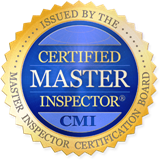

Certified Master Inspector
Providing Residential and Commercial Property Inspections for Muskoka
8 a.m. to 7 p.m., 7 Days a Week
Call 705 205 4663
DoneRight1@live.ca
8 a.m. to 7 p.m., 7 Days a Week
Call 705 205 4663
DoneRight1@live.ca


Inspecting for Mould
Mould inspection and testing has emerged in the last several years as an important indoor environmental service. In conjunction with testing Labs, these tests are performed by trained and educated home inspectors as well as specialists on indoor air quality. As a home inspector in Orillia, Gravenhurst, and all of Muskoka I am often called on to take lab samples for mould testing. With this article I hope to help home, cottage, and commercial building owners and buyers understand where and what mould is, what causes mould to grow inside buildings, and the potential dangers of mould.
Mould is encountered everyday in every part of our lives, and we often encounter high levels of mould at times during the year. That musty garden smell after a rain is very often the smell of mould spores set loose in the freshly damp environment. Mould is a natural part of our everyday lives, its part of the natural breakdown of plant matter into nutrients in the soil. It occurs inside buildings as a consequence of air exchange between the outside and inside air. A building or home is not considered contaminated simply because of the presence of mould spores. Only specially designed and built structures or rooms designed to prevent the entrance of mould spores will be mould free. These include operating rooms and clean rooms for manufacturing.
All other types of homes, cottages, and commercial buildings will have some level of mould spores and/or growth. Determining the level and kinds of mould inside is key to knowing if you have a mould problem. Mould sampling provides a way to find out what types, and how many mould spores are in a given environment, and are potentially causing harm to the building or occupants. Sampling is done to help locate for removal sources of mould inside buildings.
WHAT IS MOLD?
All moulds are from the fungi family, but not all fungi ( ie. Mushrooms) are mould. Mould is considered to be the non-sexually reproducing fungi. Most mould spores are microscopic and can be easily sent airborne in great numbers where they can be inhaled or settle down in carpets, drapes, couches or any porous material. Some moulds are slimy and their spores are not easily sent airborne. Moulds primarily feed on and break down cellulose material. In nature this includes dead leaves and wood. In homes, cottages and commercial buildings there is a much wider range of manmade and natural products like paper-facing on drywall board, cotton clothes, curtains, and drapes, wooden trim, structure, and window frames.
Any mould can be almost any color. Their colour often depends on what they are growing on. The colour black, dark brown, white, red, bluish, orange cannot tell you what type of mould it is or if it is a toxic mould or not! Moulds can grow very rapidly or slowly. Based not on what kind of mould it is, but on available moisture, temperature, and kind of material it is growing on gives moulds unique the colours you see.
TYPES OF MOULD
A large number of moulds are able to produce a hypersensitive response in people, including allergic and asthmatic reactions, in sensitized people. In rare cases mould can cause disease, but this is unusual to find outside of hospitals. As a home inspector in the Orillia, Gravenhurst, and Muskoka area I see and test for mould in homes cottages and commercial buildings regularly. Identifying the types of mould I leave to the lab, the only way to identify moulds correctly. Knowing what to recommend to my clients after the lab report returns, means I must understand the types of mould in the structure and their effects on both the structure and on the clients who may soon inhabit the home.
In short there are three types that affect people, my most important consideration. The most common finding in Muskoka, Orillia, and Gravenhurst when I test for mould is allergenic moulds.
Allergenic moulds cause allergic symptoms (Type I hypersensitivity) But they can also trigger asthma attacks in susceptible persons. Modern medicine does not consider mould as a cause of the disease called asthma. Runny noses, nasal congestion, wheezing, sneezing, and itching, watery eyes, skin rash and itching (dermatitis), chest tightness and shortness of breath have all been attributed symptoms caused by mould .
In my mould testing I have on one very rare occasion found Pathogenic mould present.
Pathogenic moulds cause infectious diseases and can affect people with weakened immune systems, such as those who are immune-compromised or immune-suppressed from drug treatment. Such infections can affect the skin, eyes, lungs or other organs. These are considered opportunistic infections that usually do not affect healthy people. Thankfully there are very few moulds that are pathogenic and in the case I found it, it was in an abandoned building with a heavy rodent infestation.
Mycotoxic moulds are those that have a high content of fungal poisons (mycotoxins) and may cause severe symptoms. This is a controversial aspect of mould because little is known about fungal toxins and how inhaling them affects people. Evidence supports concluding mycotoxin exposure can cause mucous membrane irritation and respiratory inflammation, fatigue, headaches, mood swings, and even memory loss. People most susceptible to mycotoxic mould are those who are immune-compromised or immune-suppressed from drug treatment.
Part of the lab report might also include the term Hyphae. The “root-like” structures of moulds are called “Hyphae” and can be allergenic. They are heavy and difficult to put in the air except by active disturbance. I will often get lab results with elevated Hyphae counts in buildings that are undergoing or have just completed renovations.
Mould is everywhere.
Mould spores and fungi are everywhere in our homes, offices and outdoors. Mould spores can reach very high numbers outside at certain times of the year like summer and fall. They are also at elevated levels during certain activities like harvesting and cutting grass. Finding certain types of mould and high numbers of mould growing inside buildings is unusual and generally a result of a water intrusion. Excess moisture in buildings can cause mould growth in places like, crawlspaces, attics, bathrooms, air vents, and under sinks. Food sources suitable for mould growth are typically cellulose-based, like paper-faced gypsum board, plastics, paint, and dust in heating and air conditioning systems, and dirty fibreglass insulation. Excessive mould growth needs just available water and a food source. Moisture intrusion into structures meets these requirements handily.
Mould growth can occur in as little as 24 to 48 hours when conditions are favourable so it is important to find, fix and dry water intrusion events quickly to prevent mould growth. Mould grows well at room temperature, but can grow at much higher or lower temperatures. Mould can grow in dark places and well lighted places just the same. Breathing excessive amounts of mould spores and touching mould with your skin should be avoided. First rule of mould inspection is if you suspect it, have it lab tested. Keep in mind that only a certified lab can tell what type of mould is present and mould testing requires safety precautions depending on location and context. Perhaps the most important thing to remember though is: if you don’t have a water problem, you don’t have a mould problem.